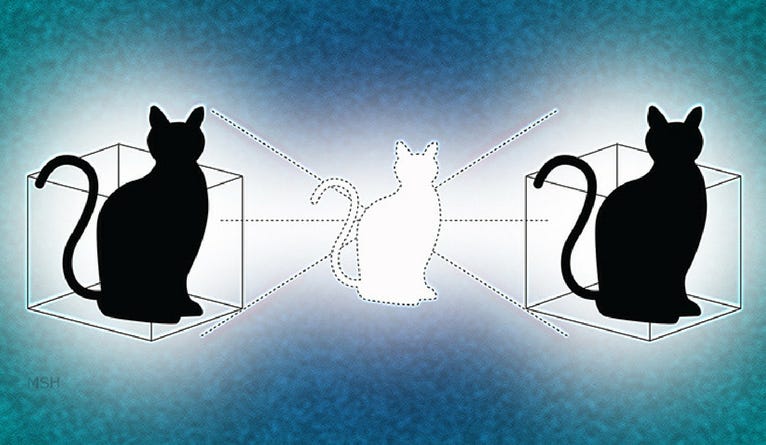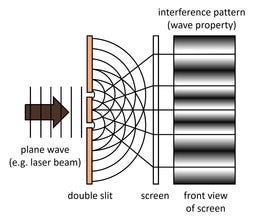Quantum Mechanics and the NYC Subway
Schrodinger's cat, the double-slit experiment, and the reason why my train is always nine minutes away from me no matter what f'ing time I get there.
Disclaimer: I am not a scientist. In this post, I will be explaining concepts about quantum physics that I don’t really understand. Read at your own risk.
On my way to work this morning, I noticed something strange. A phenomenon which thwarts all explanation. A law of the universe which defies mathematical sense and logical reasoning.
I take two trains in the morning. My first train comes every four minutes. The second—well, that’s what I’m trying to figure out. No matter what, I find myself waiting for this second train for exactly nine minutes.
I usually miss my first train by a fraction of a second, and have to wait four minutes for another one. I then board the four-minutes-later train, annoyed and somewhat stressed because I’m now cutting it close to being late for work. When I get to my stop, I rush to the other platform in the vain hope of catching my next train, but to no avail. As always, the thing is nine minutes away.
Occasionally, though, I manage to make it onto that first train, and this is where things start to get strange. Paint the picture in your head. I sit down, relaxed, basking in the pleasure of having finally become responsible enough to embark on my commute with four minutes to spare. I’m listening to music, enjoying life. I get off the train, absolutely book it to the next platform, just like always, and then deflate. It’s a nine minute wait. Again.
It doesn’t make sense. The math just doesn’t check out. If it’s nine minutes away when the I catch the earlier train, then shouldn’t it be five minutes away when I catch the later train? Theoretically, I should be getting to work at the same time no matter what time I get on the first train. How can it be a nine minute wait every time?
When logic defies itself, there’s only one place to turn: quantum physics.
You may have heard of Schrodinger’s cat. It’s a thought experiment used to illustrate a concept in quantum mechanics called ‘superposition.’
It goes something like this:
There’s a cat in a box. There’s also a poison in the box, which has a 50/50 chance of killing the cat. The box is closed. The cat is out of sight. Is it alive or dead?
According to this thought experiment, the cat exists in a state of ‘superposition,’ meaning that it hasn’t been decided yet (some might say that the cat is ‘both alive and dead at the same time’—like that’s not at all confusing). What this means is that a reality in which the cat is alive and a reality in which the cat is dead both exist in potentiality, and a final ‘decision’ (for lack of a better word) about which is to be realized will only made once someone opens the box.
This is starting to sound like nonsense, right?
That’s because it is. Apparently, Erwin Schrodinger conceived of the experiment in order to illustrate how people were misinterpreting a concept in quantum physics (kind of like what I’m doing right now with this train thing).
However, the concept it attempts to illustrate—called the observer effect—is absolutely true. On the quantum level, particles of matter can actually behave differently when they know they are being watched.
It’s strange, but true. Physicists have proved it. To find out how, we’re going to take a look at the Double Slit Experiment.
Before I confuse you, here are some videos made by people who actually know what they’re talking about, who will undoubtedly explain it better than I will.
This is a clear and detailed explanation from physicist Jim Al-Khalili:
If your attention span is short and you don’t feel like watching someone talk for nine minutes, here’s a fun animated one that will wrap up the concept in five:
Alright, I hope you watched those, because otherwise you might not be able to follow this, but here goes—my attempt at “The Double-Slit Experiment for Dummies”:
In the 1800s, scientist Thomas Young shot a beam of light through a screen with two slits cut out of it and onto a wall. He discovered that as the waves of light passed through the slits, they spread out and overlapped, and as they did so they interfered with one another, forming an ‘interference pattern’ on the back wall which looked like this:
This is because light is a wave. Well, it can actually be classified as both a wave and a particle, but in this context, it behaves like a wave.
Anyway, that was it for a hundred years, until another scientist (whose name I don’t know) decided to do the same thing with electrons. He cut two slits out of a screen and fired a bunch of electrons through the screen at a wall. Since electrons are particles, not waves, he was expecting them to form a pattern like this:
That’s not what happened. Instead, the pattern they formed an interference pattern, which looked like this:
This puzzled scientists. Waves are supposed to do that. Electrons are particles. Why were they behaving like waves and not particles? In order to see what was going on, scientists decided to perform the experiment again, this time with a camera to record what was going on.
This is where things get really weird. With the camera observing their movement, the electrons behaved like particles, and formed the expected pattern:
Huh? Strange, right? Every time this experiment has been repeated, the results were the same. When there is an ‘observer’ (the camera) the electrons act like particles. When there is no ‘observer,’ the electrons act like waves.
What’s going on here? No one really knows, but there are some theories, one of which sounds a lot like Schrodinger’s cat. Before they are observed, the electrons exist in ‘superposition’—there are a set number of possible positions they could take, and before they are observed, they exist entirely as potential (they are any and all of them at the same time). These ‘potentialities’ might interfere with one another, much like waves do. However, once there is an observer, the electrons have to pick a position.
I don’t know if that made sense, and I doubt I got it all right. Don’t quote me, and watch the videos. Seriously.
But anyway, I started this whole thing because I wanted to talk about the train, and now I’m finally going to do that. Here goes.
My hypothesis for why my second train is always nine minutes away when I get to the platform is this: I am the observer, and until I arrive, the train exists in superposition, having the potential to either arrive four minutes earlier or four minutes later. Once I get there, it assumes its position, which is always nine minutes away from me.
Ta da.
I know what you’re going to say. “That’s ridicuous, Melissa.” And you’re not wrong. But the subway is a strange place. Time extends and shrinks at will, wait times can double or triple, and sometimes a train ride takes seven minutes when other times it takes fifteen. Time kind of ceases to have any meaning down there as it is (I’m sure there’s a quantum physics parallel there somewhere). Maybe the reason why none of us can figure the system out is because we’re trying to apply the laws of common sense, when in reality, the laws it follows are quantum laws.
It’s not completely out of the realm of possibility. After all, trains are operated by humans. Thus, their schedules are not governed by the laws of ordinary physics, but by the laws of sociology. Maybe human behavior within large, inefficient bureaucratic systems somehow follows the laws of quantum mechanics. I’ll bet no one’s tested that one out before.
Your move, scientists. Have at it, because I can’t think of any other explanation.
Seriously, though, the train thing is obviously a joke, but if I got anything else wrong about the physics in this post, rip me a new one in the comments.
Thanks for reading. If you enjoyed this post and would like to support my work, consider becoming a free or paid subscriber.










Melissa, trust me you’re spot on! So I talk about this in a plethora of articles on my stack, but I’ll limit myself to posting 3 of them! For one, there is an entirely metaphysical universe that underlays on our physical material universe. Older books like The Kyballion or Hermetica, touch on this.
Two, we have to realize that science, for the past 200 years have literally removed all information on this metaphysical space from our knowledge. So we experience events like synchronicity, magic, miracles or quantum physics and are limited to two options: God or Luck. Turns out, there’s a lot out there, for us to find out.
Three, you’re 100% spot on with the Double Slit experiment. Observation creates waves and I have an article I’m going to write called a “wave based” reality. The idea is how we can send ripples through this metaphysical space and how that can impact our lives: in your situation 9mins ever-time.
So to close, you’re 100% spot on and it sounds like you’re literally controlling your space! To really understand how this world was obstructed from our eyes, I’d recommend my book “an Unorthodox Truth.” It shows how this physical world was given to us and how the spiritual world was hidden from us — while THEY use it on us!
PS: for example, older scientific books talk about the “Ether,” this substance that covers the earth and how electricity works. But ask a modern scientist about the ether and the response is: No, that doesn’t exist.
Here are the three links that I hope help in this journey. Welcome, it’s an amazing one 😊
Link for my book: https://www.unorthodoxtruth.com/
The reality of magic (an excerpt from my book): https://unorthodoxy.substack.com/p/the-reality-of-magic
Why we need to explore spirituality in our reality: https://unorthodoxy.substack.com/p/the-spiritual-perspective-of-reality
Kyballion and Morphic Resonance: https://unorthodoxy.substack.com/p/the-morphic-resonance-field-of-the
Hope this helps and let me know if any questions!
Hmm. My knowledge of quantum mechanics is what I've discerned from half-read books by Stephen Hawking, Brian Greene and Michio Kaku, the kind of stuff I read in public so people in the know think I'm bright (but we all know the sad truth, wink wink).
You are positing something quite astounding about the subterranean world of subways, rails and platforms! As we all know, and misunderstand, the quantum realm explains the subatomic world, not the big, laborious world of man and his smelly commuter machines. The double-slit explains photons more coherently than subway trains.
Unless we become subatomic entities when we descend underground.
I'm reminded of the Disney ride Inner Space from the "old days." In the ride, you were reduced to the size of a microscopic particle, and you journeyed through the world as an atom, and saw everything through those eyes. In such a case, you would be subject to quantum law. Does this happen to us on subways?
Given the subway field, this may be a question for Schrodinger's Rat.